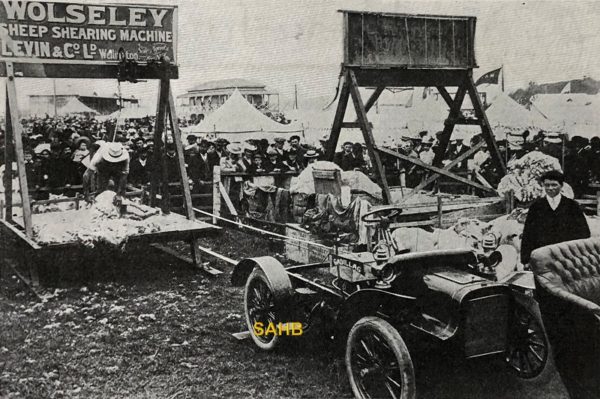
It is difficult to date this Cadillac, captured helping to shear sheep in New Zealand. The image is from 1908, but it would be rare to find a brand-new car being used to drive a sheep shearing machine. However, the Cadillac sign on the side of the car might indicate a promotional stunt by the car company. The radiator and scuttle certainly date from around the 1906-1908 period.
Of equal historical importance in this picture is the Wolseley sheep shearing machine. Frederick York Wolseley (1837-1899) was an Irish-born New South Wales inventor and woolgrower who invented and developed the first commercially successful sheep shearing machinery. It revolutionised the wool industry.
Born in Kingstown (now Dún Laoghaire) in County Dublin, Wolseley lost his father in 1840, leaving his mother with seven children and little money to educate them. Wolseley sought his fortune in Australia, arriving in Melbourne in 1854 to be a jackaroo on the sheep station of the future husband of his sister Fanny.
By 1872, Wolseley had created a working model of a sheep shearing machine. After several failures, he was awarded a patent with Richard Park for an ‘Improved Shearing Apparatus’ on 13 December 1884. In 1887–1888, demonstrations were arranged throughout eastern Australia and New Zealand; the first complete shearing by machinery took place in New South Wales and in 1888 eighteen more woolsheds were equipped with Wolseley machinery.
During 1887, Herbert Austin joined, as chief engineer, Wolseley Sheep Shearing Machine Company Limited, incorporated in Sydney. In 1893 Austin and Wolseley were in England, where an English operation was set up in Birmingham. Wolseley died in 1899.
Our Snapshot shows a scene typical of the demonstrations held across Australia and New Zealand. From earliest times, wool had been clipped from the sheep’s back by hand shears. Wolseley invented and developed the first satisfactory mechanical method using a power source away from the shearer’s hand. As well as relieving the shearer’s hand of the cutting effort, the machine clipped the wool at its full length, which often doubled or tripled its value. It also removed the wool in a fleece instead of chopping it into small pieces.
It is just possible that a Wolseley or Austin car could have been used in this demonstration. Herbert Austin started to look for diversification from the highly seasonal wool shearing trade as early as 1895. His skills came to the attention of Hiram Maxim of Vickers, Sons and Maxim and, when the sheep shearing company decided against entering car production, Maxim and the Vickers brothers set up the Wolseley Tool and Motor Car Company in 1901 to make cars and tools, with Herbert Austin as managing director. After his five-year contract with the Wolseley car firm ended in 1906, Austin founded The Austin Motor Company Limited.
Image courtesy of The Richard Roberts Archive: www.richardrobertsarchive.org.uk







Is the machine being driven from the Cadillac’s left rear wheel?
That is a very good question. The top and bottom of the long drive belt from car to shearing machine are parallel; this implies that the left rear wheel had been jacked up off the ground and the belt had been placed round the wheel (since the wheel flanges would have stopped the belt slipping off). The right rear wheel is on the ground, so the differential would allow the the left rear wheel to rotate in the opposite direction to the normal drive. I have no proof of this, however.